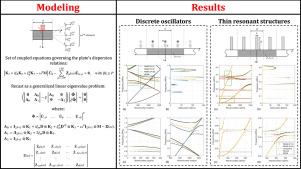PSAFE: A semi-analytical finite element formulation for spatially periodic structural systems
IF 4.9
2区 工程技术
Q1 ACOUSTICS
引用次数: 0
Abstract
In this article, we present a semi-analytical finite element (SAFE) scheme that enables modeling spatially periodic structural systems. This represents a fundamental extension of the existing SAFE methods, which strictly require translational invariance along the wave propagation direction. Specifically, we develop a formulation that considers viscoelastic plates equipped with regularly spaced resonant structures under plane-strain conditions. Our approach involves (i) imposing Bloch conditions on the unknown displacement field within the plate, (ii) discretizing only the plate’s cross-section, and (iii) modeling the resonant structures as periodic mechanical impedances. This effectively transforms the problem into Fourier space, where the geometrical coordinates are replaced by their Fourier series expansion counterparts. As a result, we obtain an infinite set of coupled equations governing the plate’s dispersion relations, each of which corresponding to a specific Fourier coefficient and containing an infinite number of terms associated with the periodic resonant structures. To solve this problem numerically, we truncate the infinite series to a finite number of terms and then recast the system into a linearized eigenvalue problem. By means of two case studies, we show that accurate results can be achieved even with low truncation orders, and that the accuracy can be refined by increasing the system’s dimensionality, though at the cost of higher computational expense.

空间周期结构系统的半解析有限元公式
在本文中,我们提出了一种半解析有限元(SAFE)方案,可以对空间周期性结构系统进行建模。这代表了现有的SAFE方法的基本扩展,这些方法严格要求沿波传播方向的平移不变性。具体来说,我们开发了一个公式,考虑在平面应变条件下配备有规则间隔共振结构的粘弹性板。我们的方法包括(i)对板内未知位移场施加布洛赫条件,(ii)仅对板的横截面进行离散化,以及(iii)将共振结构建模为周期性机械阻抗。这有效地将问题转化为傅里叶空间,其中几何坐标被傅里叶级数展开的对应项所取代。结果,我们得到了控制板色散关系的无限组耦合方程,每个方程对应于一个特定的傅里叶系数,并包含与周期谐振结构相关的无限项。为了在数值上解决这个问题,我们将无穷级数截断为有限项,然后将系统重新转换为线性化的特征值问题。通过两个实例研究,我们表明,即使截断阶数较低,也可以获得准确的结果,并且可以通过增加系统的维数来改进精度,尽管以更高的计算费用为代价。
本文章由计算机程序翻译,如有差异,请以英文原文为准。
求助全文
约1分钟内获得全文
求助全文
来源期刊

Journal of Sound and Vibration
工程技术-工程:机械
CiteScore
9.10
自引率
10.60%
发文量
551
审稿时长
69 days
期刊介绍:
The Journal of Sound and Vibration (JSV) is an independent journal devoted to the prompt publication of original papers, both theoretical and experimental, that provide new information on any aspect of sound or vibration. There is an emphasis on fundamental work that has potential for practical application.
JSV was founded and operates on the premise that the subject of sound and vibration requires a journal that publishes papers of a high technical standard across the various subdisciplines, thus facilitating awareness of techniques and discoveries in one area that may be applicable in others.
 求助内容:
求助内容: 应助结果提醒方式:
应助结果提醒方式:


